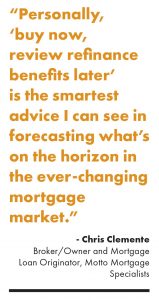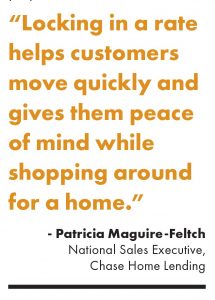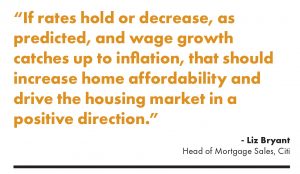 Liz Bryant moderates a conversation with Chris Clemente (managing broker/owner – vice president at Motto Mortgage Specialists) and Patricia Maguire-Feltch (managing director, mortgage banking consumer originations sales executive, Chase Home Lending).
Liz Bryant moderates a conversation with Chris Clemente (managing broker/owner – vice president at Motto Mortgage Specialists) and Patricia Maguire-Feltch (managing director, mortgage banking consumer originations sales executive, Chase Home Lending).
From a pain-staking series of interest-rate increases and dogged inflation, to out-of-reach prices and sparse inventory, consumer confidence in homebuying has suffered a serious blow this year. With all-cash offers ruling the roost in a competitive landscape, mortgage lenders have amplified innovation to help get worthy buyers into their much-desired home.
In this special insiders’ roundtable, three mortgage leaders discuss the realities of today’s market and share tangible solutions that real estate professionals can use to help their clients carve a path to homeownership in today’s taxing economic environment.
Please describe some of the biggest challenges facing mortgage lenders and their clients in today’s residential real estate environment.
Liz Bryant: It won’t come as a surprise to hear that the most acute challenges facing lenders and their clients today are continued observance of inflation coupled with housing inventory shortages. These factors together have caused a rise in home prices and have impacted affordability—impacting buyers in the low- and middle-income range the hardest.
Chris Clemente: Consumer perceptions of the rate environment have been a huge challenge to our industry, most specifically since interest rates started increasing last year. We, as consumers, have been spoiled with lower-than-average mortgage interest rates for the past decade. Now, new consumers contemplating entering the real estate market are concerned their payments will be too high to afford, and existing buyers feel that using their equity for their next move isn’t a good tradeoff to higher payments on their next home.
As Liz mentioned, we’re also facing an inventory challenge with many parts of the U.S. still limited on residential inventory. In addition, many buyers and sellers are on the fence, hoping mortgage rates will come down. What does this mean? When the rates come down, and many believe they will, we will be back to seeing multiple offers, which will increase property values. When this happens, many sellers and buyers will come off the fence to list and/or buy, and a parallel refinance boom will occur. It’s crucial for mortgage professionals to educate their borrowers. Personally, “buy now, review refinance benefits later” is the smartest advice I can see in forecasting what’s on the horizon in the ever-changing mortgage market.
Patricia Maguire-Feltch: I agree, education is key. Some of the biggest challenges facing buyers in today’s market are a lack of understanding about the process, affording down payment and closing costs, and the competitive landscape, combined with economic uncertainty.
For lenders, it’s a tough environment because there isn’t as much opportunity as there’s been in recent years. Originators may be feeling like it’s twice as hard to produce a fraction of the business they were seeing previously.
Please explain how these overall economic issues and rising rates have impacted the purchase segment of the business.
Chris Clemente: One of the biggest impacts I’ve seen is the barrier to entry for first-time homebuyers. Higher rates make it more difficult for the traditional first-time homebuyer to afford monthly mortgage payments. Rising insurance costs and higher property taxes—due to escalating property values—are also factors in higher mortgage payments. Finally, as sellers decide which offers to accept, they have been reluctant to choose outside of a cash or conventional mortgage offer despite there being numerous loan products that make it more affordable. This leaves the majority of first-time homebuyers out of luck.
Patricia Maguire-Feltch: It’s generally true that people buy homes when they are financially ready, regardless of the current market. However, current market conditions have contributed to many would-be homebuyers believing that homeownership is out of reach. As a result, Chase has introduced a refreshed suite of resources and benefits to support buyers in today’s housing market and on their path to homeownership, such as Lock and Shop. This offering allows buyers to lock in their mortgage rate for 90 days with no upfront fee when using Chase Homebuyer Advantage. Locking in a rate helps customers move quickly and gives them peace of mind while shopping around for a home.
Liz Bryant: All good points. Additionally, as mortgage rates move higher, we’ve seen contraction in the refinance transactions segment. Borrowers may find their potential savings from refinance diminished. That said, the Mortgage Bankers Association (MBA) projections point to increased purchase volume in the back half of 2023 and into 2024.
 So given this variety of circumstances, how are you educating consumers to understand fact versus fiction when it comes to today’s home-buying environment—including the potential opportunities?
So given this variety of circumstances, how are you educating consumers to understand fact versus fiction when it comes to today’s home-buying environment—including the potential opportunities?
Patricia Maguire-Feltch: Chase is focused on helping improve homebuyer education with resources to help break down what can seem like a complex process. For example, Chase introduced the Beginner to Buyer podcast in 2021 as a way to empower buyers with the education they need to begin the home-buying process and manage the responsibilities of homeownership. The podcast, which just debuted its second season in May, now includes 20 episodes featuring conversations with real homebuyers and owners discussing their experiences, along with expert guests. It takes a deep dive into the questions that many prospective homebuyers are wondering, but often too afraid to ask.
For example, episode five of season two debunks common misconceptions about homebuying and ownership, including whether you really need to put 20% down, if you can buy a home when you have student loans, and more.
 Liz Bryant: Providing that type of information is so important, because there’s so much conflicting information out there—it’s no wonder that prospective homebuyers are coming to us with some confusion, uncertainty and even a little anxiety. Still, our approach to educating clients in today’s market and instilling them with confidence is no different than how we would educate them in any market. It starts with our loan officers building a relationship with prospective buyers. Together, they’ll identify the client’s goals and lend their years of experience as they walk through the entire home-buying process in detail, presenting individualized loan options. The ideal outcome for a client may be to walk away with a better understanding of the process, rather than a purchase.
Liz Bryant: Providing that type of information is so important, because there’s so much conflicting information out there—it’s no wonder that prospective homebuyers are coming to us with some confusion, uncertainty and even a little anxiety. Still, our approach to educating clients in today’s market and instilling them with confidence is no different than how we would educate them in any market. It starts with our loan officers building a relationship with prospective buyers. Together, they’ll identify the client’s goals and lend their years of experience as they walk through the entire home-buying process in detail, presenting individualized loan options. The ideal outcome for a client may be to walk away with a better understanding of the process, rather than a purchase.
It is also important to help prospective homebuyers understand that there are options for first-time homebuyers, including low down payment loans. As Patricia mentioned, there is often a misperception that 20% down is required to purchase a home. That is not the case. Over time, we win by building the confidence of more clients and serving as a trusted source of information, whether or not any particular interaction results in an immediate purchase.
Chris Clemente: We also encourage our customers to dialogue for a deeper understanding of the mortgage process. We welcome questions and, most importantly, keep them engaged and informed on every step of the mortgage origination, approval and closing processes. We recommend first-time homebuyer classes to most mortgage applicants so they can better understand the process and requirements of purchasing a home. Furthermore, we encourage our customers to print out and read their consumer Home Loan Tool Kit, which is part of their required Federal disclosure package from the lender. It provides valuable information that gives the consumer the ability to make better choices during the home-buying process.
I love the focus on education. Tell us about some of the specific solutions you have developed to help buyers secure a mortgage.
Liz Bryant: This is an area that I’m so proud of at Citi, and it’s picked up steam since the launch of our firmwide Action for Racial Equity in 2020. That’s when we took a closer look at our bank, and across mortgage, we asked ourselves how we could drive more investment in affordable housing and sustainable homeownership.
Two years later, we announced new solutions to advance racial equity and access to homeownership. We expanded our HomeRun low down payment mortgage and Lender Paid Assistance (LPA) programs through a new special purpose credit program, widening the reach to majority-Black and majority-Hispanic census tracts outside physical Citibank locations. Expansion cities included Atlanta, Austin, Cambridge, Dallas, Denver, Houston and Philadelphia.
Alongside the geographic expansion, we increased the HomeRun income eligibility threshold from 80% of area median income (AMI) to 120% of AMI. LPA now covers up to $7,500 in closing costs, up from $5,000, for qualifying borrowers. These actions have helped lead to a 12% rise in mortgage penetration rate in majority-minority census tracts. These numbers motivate us here at Citi to keep thinking of innovative ways we can make homeownership a reality for more people.
 Patricia Maguire-Feltch: At Chase, the pandemic served as a catalyst for the move to a digital-first home-buying process. While we serve many who still prefer to complete the home-buying journey in person, there are now resources available to help you navigate the process completely online. For example, Chase MyHome is an interactive, all-in-one tool that helps consumers with every stage of homeownership—from home search and mortgage application to closing. Once they’ve purchased a home, homeowners can use the tool to keep track of their mortgage payments, review their home’s value and learn about potential savings.
Patricia Maguire-Feltch: At Chase, the pandemic served as a catalyst for the move to a digital-first home-buying process. While we serve many who still prefer to complete the home-buying journey in person, there are now resources available to help you navigate the process completely online. For example, Chase MyHome is an interactive, all-in-one tool that helps consumers with every stage of homeownership—from home search and mortgage application to closing. Once they’ve purchased a home, homeowners can use the tool to keep track of their mortgage payments, review their home’s value and learn about potential savings.
Additionally, one of the biggest barriers to homeownership is affording the upfront cash, such as closing costs and down payment. Many homebuyers aren’t aware that there are a variety of assistance programs available to help buyers. So, we launched the Homebuyer Assistance Finder earlier this year to help prospective buyers identify grants and assistance programs they may be eligible for. Chase also offers homebuyer grants up to $5,000 in select markets across the country to help with down payment and closing costs.
Chris Clemente: In addition to providing various solutions, we believe that agents should engage mortgage professionals very early in the home-buying process. This allows us to foster a more controlled environment to identify any credit, income or asset issues long before consumers begin to look at properties. In a perfect world, consumers would seek a mortgage prequalification before engaging an agent. Mortgage brokers have a huge advantage in the mortgage lending space. We can shop multiple lenders with specialty programs and flexible guidelines to offer competitive rates, unparalleled service and the overall best experience.
Tell us more about how you’re engaging real estate professionals to help them get buyers into homes.
Chris Clemente: The partnership between mortgage professional and agent is crucial to have a smooth transaction for buyers and sellers. At Motto Mortgage Specialists, we’ve seen great success in helping clients get into homes by offering mortgage education classes for real estate brokers and agents in our area. We also make ourselves available at open houses to engage and interact with existing and potential customers, and network with our agent partners.
Liz Bryant: We’ve recently expanded our community lending team and its network of correspondent lenders to increase access to our mortgage products and services among minority borrowers in low- and moderate-income neighborhoods.
I’m proud of the work our team has done to expand our roster of Community Loan Officers (CLOs), who help clients navigate the home-buying process with confidence. CLOs are specialized Home Loan Officers (HLOs) who facilitate sales and client relationships through engagement with the community, diverse REALTORS® and affordable housing nonprofits. Some of the ways CLOs work with community members include helping to fill out and file mortgage applications, offering advice on products that best fit a client’s needs and communicating to the client the status of a loan as it progresses through each stage of the mortgage process. We also employ Business Development Officers (BDOs) to facilitate new client relationships by providing information on Citi’s products and services to community members and engaging with diverse REALTOR® groups and nonprofits, such as the Asian Real Estate Association of America, National Association of Real Estate Brokers and the National Association of Hispanic Real Estate Professionals.
Patricia Maguire-Feltch: In the mortgage business, partnership with real estate professionals is a must. We work with real estate professionals every day in serving our joint clients, and we also have our Chase Agent Express program. Homebuyers and sellers who find and work with an agent who is part of Chase Agent Express can be rewarded with up to $5,000.
Additionally, we know how important it is to instill confidence with real estate professionals and clients that we can close quickly. Chase’s Closing Guarantee commits to an on-time closing, in as little as 21 days, or gives them $5,000 cash.
 Finally, what is your outlook for the home-loan environment in 2024? What market factors may sway this outlook in either direction?
Finally, what is your outlook for the home-loan environment in 2024? What market factors may sway this outlook in either direction?
Patricia Maguire-Feltch: The housing market is always changing, and we can’t predict with certainty whether rates will increase, decrease or stabilize. Home prices in some areas of the country have started to slowly decrease, but with all things considered, I anticipate we’ll continue to see a balanced market between sellers and buyers, similar to 2023.
Based on the latest research from the Conference Board, it seems that consumers are less worried about inflation and a potential recession. In June, consumer confidence jumped higher than we’ve seen it in 17 months, and inflation appears to be slowing down. At the same time, unemployment is relatively low, and both job and wage growth are steady. So, as always, there are many economic factors that play into what the housing market looks like. What we do know is homebuyers who are financially prepared will enter the market in 2024, and we’re here to help them.
Chris Clemente: If we look at the past being a probable predictor of the future, a lower rate environment will encourage more sellers to sell, homebuyers to purchase and more existing homeowners to refinance for lower rates or to cash in their equity. Personally, I believe the rates will trend lower in 2024, putting us in one of the busiest times in our real estate history. This will also be a tremendous opportunity for Americans to gain wealth through homeownership.
Liz Bryant: Despite some of the headlines, MBA projections point to an improved purchase market in 2024; however, we’re continuing to watch closely, as this projection is contingent on rates, inflation and real wages. Home prices are starting to level off and, in some markets, even decline slightly. If rates hold or decrease, as predicted, and wage growth catches up to inflation, that should increase home affordability and drive the housing market in a positive direction.
All that to say, we’re looking forward to helping our clients navigate the home-buying process and matching them with the best products and services for their needs, whether they end up purchasing now or a decade from now.
For more information about our cover story companies, visit https://www.citi.com/mortgage/home-mortgage, https://www.mottomortgagespecialists.com or www.chase.com/BenefitsandOffers.
Maria Patterson is RISMedia’s executive vice president.












